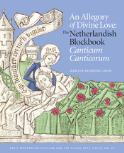|
An Allegory of Divine Love: The Netherlandish Blockbook Canticum Canticorum
|
|
Marilyn Aronberg Lavin
|

|

The Netherlandish Canticum Canticorum is a late 15th-century blockbook ordinarily bound with larger, more impressive, and better known blockbooks, particularly the Biblia Pauperum and the Speculum Humanae Salvationis.
An Allegory of Divine Love offers the first art-historical analysis of the Canticum Canticorum, Latin for Song of Songs, as an independent work of art of the highest caliber: rather than the end of a long Gothic tradition, it is revealed as a major work of Early Renaissance art, full of beautiful compositions, original ideas, and an intellectual challenge to a devoted, reading public. This blockbook is composed of eight large sheets of paper, stacked and gathered in the center to form sixteen folios, printed by hand rubbing on one side only; there are four rectangular woodcut compositions involving haloed figures, landscapes and interiors, on each opening, with thirty-two scenes in all.
As a blockbook, the Canticum's most salient feature is the fact that it has no printed identification. The sheets bear no page-signatures or rubrics. The framed scenes contain no titles. There is no commentary of any kind. The title page contains the words Canticum Canticorum, but nothing more.
The author discusses each of the thirty-two framed scenes individually, as visual images within the larger framework of the history of art, as poetic dialogues composed of hallowed lines newly ordered to create a new poem, and as theological allusions in the form of human interaction.
Marilyn Aronberg Lavin is a senior scholar in the field of Italian art history, who lives and works in Princeton, N.J. She has been visiting professor of art history at Princeton, Yale, and the University of Maryland. The author of several books on Piero della Francesca, she has also been a pioneer in the use of computers (database research and three-dimensional walk-through reconstructions) for the history of art. Her book, Seventeenth-Century Barberini Documents and Inventories of Art (New York University Press, 1975), won the Charles Rufus Morey Award from the College Art Association.
|
|
